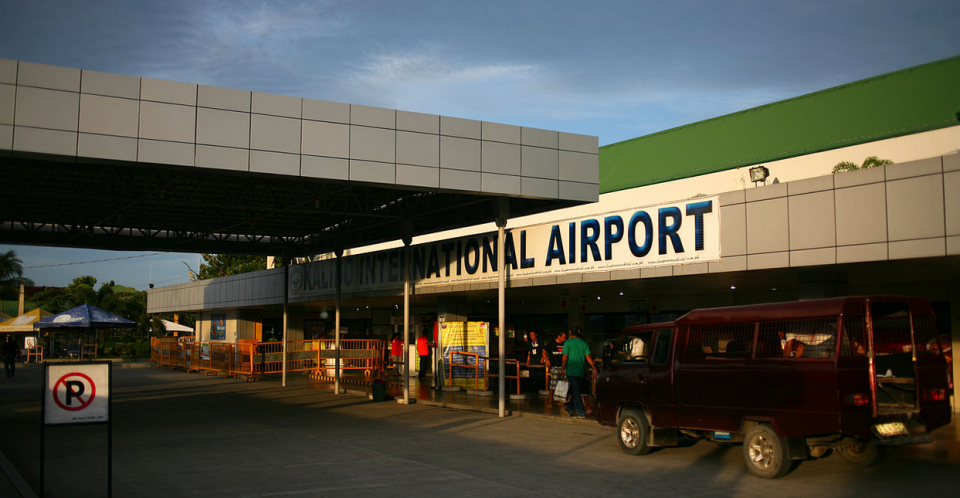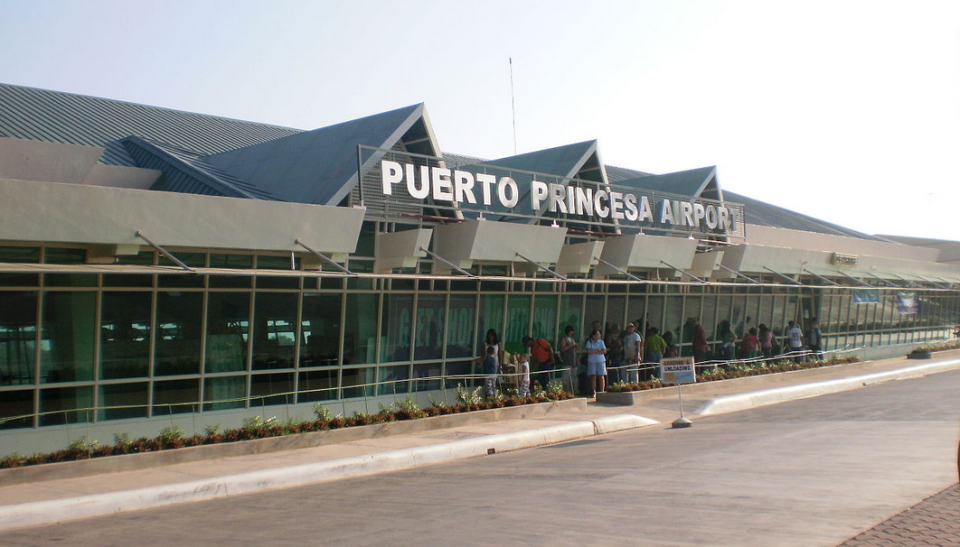Francisco Bangoy International Airport
also called Davao International Airport (IATA: DVO, ICAO:RPMD)
From Wikipedia, the free encyclopedia
Is the main airport serving Davao City in the Philippines. It is the busiest airport on the island of Mindanao. The airport has a single 3,000-meter precision runway.
A new terminal replaces the previous airport terminals, which lie just across it, in handling both domestic and international flights operating to and from Davao. The modern facility is designed to handle approximately 2 million passengers annually and 84,600 metric tons of cargo annually. The added capacity is also complemented by the latest navigational, security, and baggage handling equipment.
The modernization and upgrading of the airport facilities aims to cement Davao as a hub for tourism and foreign investment in the region
Terminal
The P2.7 billion passenger terminal is a Malay architecture-inspired building which is four times larger than the old terminal. It is highly computerized, more secure and has more commercial spaces for concessionaries at approximately 9,000 sq. meter. It has four units of jet bridges for passengers. It has also a Flight Information Display System and Closed-circuit television system complementing the terminal’s security system.
The terminal has 14 domestic and 14 international check-in counters that can handle a steady flow of passenger traffic. The Check-in counters are equipped with electronic weighing scales and conveyors and its baggage handling system is also computerized. It also has 2 arrival areas, for domestic and international with 2 baggage conveyors each. The Cargo Terminal Building covers almost 5,580 sq. meters and can handle up to 84,600 metric tons of cargo a year.
Iloilo International Airport
From Wikipedia, the free encyclopedia
(IATA: ILO, ICAO: RPVI), also known as Iloilo Airport, and as Cabatuan Airport,[4] after the municipality of Cabatuan, Iloilo[2] where it is located and sometimes Santa Barbara Airport for the nearby municipality of Santa Barbara, Iloilo.[5] The airport serves the Province of Iloilo,[6] including its capital city, Iloilo City, the regional center of the Western Visayas region in the Philippines. The airport can be reached using either the Barangay Tabucan and Barangay Tiring access road, or the Barangay Duyan-Duyan, Cabatuan access road.
Passenger terminal
The airport has a 13,700-square-meter (147,000 sq ft) main passenger terminal designed to accommodate around 1.2 million passengers annually.[56] Believed to be one of the most beautifully designed airport terminals in the Philippines, its architectural style is said to be reminiscent of Hong Kong International Airport, albeit on a smaller scale.[57] It is divided into three levels: arrivals and baggage claim on the first floor, check-in on the second floor and departures on the third floor.[28] The pre-departure area at Iloilo International Airport has a capacity of 436 passengers.[10] Three jet bridges protrude from the terminal above a 48,000-square-meter (520,000 sq ft) apron,[28] enabling Iloilo International Airport to handle up to six aircraft simultaneously. When fully extended, the jet bridges stretch to a length of 35 meters (115 ft).[10]
The terminal is equipped with six X-ray machines,[10] as well as escalators and staircases for departing and arriving passengers’ use.[58] There are also two elevators, one for very important persons and one for disabled passengers.[58] Two pocket gardens have been installed at the terminal, one each for both the departure and arrival halls.[8] The building features ten modern check-in counters with LCD monitors.[10] The terminal makes extensive use of natural lighting, designed for energy efficiency. Other amenities available to passengers include a special smoking room, a Duty-free shop,[59] a VIP lounge, a Mabuhay Lounge for Philippine Airlines business class passengers and counters for hotel and car rental bookings, as well as areas for airport stores and pay phones
The Iloilo International Airport is the 4th busiest airport in the philippines about 1.8 million passenger traffic in 2012. The Iloilo Airports Authority also expect that more airlines well operate the airport due to increase of passenger traffic and constructing of new terminal building.
Access and transportation
Road
Iloilo International Airport is connected to Iloilo City proper via the Tomas Confesor Highway. The access road is wide enough to be able to accommodate four lanes of traffic. The estimated travel time to the airport from Iloilo City proper is around thirty minutes.[8]
To relieve crowding on the main access road during peak hours, a 3.2-kilometer (2.0 mi) secondary access road was constructed, connecting the airport to Cabatuan proper through Barangay Duyan-Duyan. The 124 million-peso ($2.6 million) road is expected to improve connectivity between the airport and both northern Iloilo and southern Capiz, as well as reduce travel times from there to the airport by at least fifteen minutes.[70] The two-lane road opened in July 2010.[71]
Public transportation
Although public transport routes to and from the airport are being studied, no franchises for transport services to the airport have been granted yet by the Land Transportation Franchising and Regulatory Board (LTFRB).[72] Some transport operators, however, are showing interest in starting shuttle services to the airport from Iloilo City, while others have drawn proposals for public transport routes from Iloilo City directly to the airport.[72] A shuttle service is currently available to the airport from Iloilo City, with pick-up and drop-off points at SM City Iloilo and Jaro Plaza.[8]
Taxi service is available to the airport from Iloilo City proper, with the average fare from Jaro Plaza in downtown Iloilo City costing around 163 pesos ($3.90) as of 2007.[73] However, taxi operators have filed a petition with the LTFRB to increase airport rates by 150 pesos, a move opposed by Governor Tupas as it would make taxi fares to the airport the most expensive out of any route going to an airport in the Philippines, as well as hurt the tourism industry.[73]
Iloilo International Airport is accessible via jeepney to Santa Barbara town proper, after which travelers may take a share taxi to the airport. Travelers may also take jeepneys en route to Cabatuan, Calinog or Janiuay, all of which stop at Santa Barbara.[8]
Rail
A train linking Iloilo International Airport to Iloilo City proper, similar to the Airport Express in Hong Kong and similar systems in other cities, has been proposed.[74] A study to determine the feasibility of a train service has since been commissioned by the city government.[75]Other proposals to connect the airport to the city via rail include the revival of the currently defunct Panay Railways network which has a station in Santa Barbara town proper.[76]
Kalibo International Airport
From Wikipedia, the free encyclopedia
(IATA: KLO, ICAO: RPVK) is an airport that serves the general area of Kalibo, the capital of the province of Aklan in the Philippines, and is one of two airports serving Boracay, the other being Godofredo P. Ramos Airport in the town of Malay. The airport is situated 3 km east of the main area of Kalibo and 68 km from Caticlan port in Malay. Kalibo International Airport services international destinations such as Taipei, Seoul-Incheon, Busan, Shanghai, Chengdu, Beijing, Hong Kong, Singapore and Kuala Lumpur. It offers more international destinations than domestic destinations.
Bacolod–Silay International Airport
From Wikipedia, the free encyclopedia
(IATA: BCD, ICAO: RPVB) is the main airport serving the general area of Bacolod City, the capital city of Negros Occidental in the Philippines. This airport replaced the Bacolod City Domestic Airport in 2008. The Bacolod–Silay International Airport inherited its IATA and ICAO airport codes from the former airport.
The airport is located fifteen kilometers northeast of Bacolod City on a 181-hectare site in Barangay Bagtic,[1][2][4] Silay City. The airport, which is built to handle international traffic, is expected to become the primary gateway toNegros Island. It is one of the three international airports envisioned to serve the Western Visayas region, alongside Kalibo International Airport and the Iloilo International Airport.
Passenger terminal
The entire airport complex is designed to handle an excess of one million passengers and 16,715 tons of cargo annually[5] and consists of 21 buildings with a total floor space of 10,075 square meters (108,450 sq ft).[5]
The largest building in the complex is the 6,187-square-meter (66,600 sq ft) main passenger terminal with three levels.[5] The ground floor holds the check-in counters, the public concourse, the arrival area and the information counter. The second floor has the three pre-departure areas with their VIP and CIP lounges; these pre-departure areas lead out to three jet bridges over an apron that can handle up to five aircraft simultaneously. Philippine Airlines also operates a Mabuhay Lounge for the use of its business class passengers on the second floor. Also on the second floor are Merci Pasalubong Shop and Bong-Bong’s Pasalubong Shop, occupying the spot of the former Civil Aviation Authority of the Philippines office since transferred to the Administration Building. On the third floor is the viewing deck with a concession area and rooms for maintenance and airport machinery.[12]
The state-of-the-art main passenger terminal is equipped with a flight information display system, mechanized baggage handling systems for both inbound and outbound baggage, numerous security X-ray machines, and elevators and escalators.[12] Outside the main terminal is parking for 350 cars.[5]
Transportation
Airport transportation is accessible to passengers travelling in or out of the airport from Bacolod. There are multiple Public Utility Vehicles (PUVs) that offer shuttle services. There are also tricycles outside the airport that provide transportation to nearby destinations in SilayCity. The new access road connecting the airport and Bacolod City is completed and is now accessible to vehicles, it connects to Brgy. Bata in Bacolod City.
Puerto Princesa International Airport
From Wikipedia, the free encyclopedia
(IATA: PPS, ICAO: RPVP) is an airport serving the general area of Puerto Princesa City, located in the province of Palawan in thePhilippines. It is classified as an international airport by the Civil Aviation Authority of the Philippines, with mainly domestic services, and also one international destination.
Recently, President Noynoy Aquino intended to make the airport one of the primary gateways of the Philippines aside from Clark International Airport in Clark Freeport Zone and Ninoy Aquino International Airport in the capitalManila The airport is the main gateway to the Puerto Princesa Underground River, a UNESCO World Heritage Site and one of the New 7 Wonders of Nature.

















